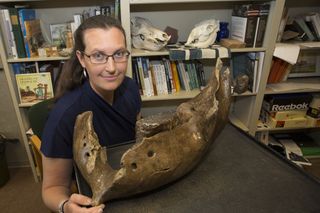Mammoths and Mastodons of the Ohio Valley Were Homebodies

People may imagine mammoths and mastodons as enormous beasts that roamed the vast North American continent more than 10,000 years ago. But the mammoths and mastodons of present-day southwestern Ohio and northwestern Kentucky were homebodies that tended to stay in one area, a new study finds.
The enamel on the animals' molars gave researchers clues as to where the mammoths and mastodons lived throughout their lives and what they ate. They discovered that mammoths ate grasses and sedges, whereas mastodons preferred leaves from trees or shrubs. Mammoths favored areas near retreating ice sheets, where grasses were plentiful, and mastodons fed near forested spaces, the researchers said.
"I suspect that this was a pretty nice place to live, relatively speaking," lead researcher Brooke Crowley, an assistant professor of geology and anthropology at the University of Cincinnati, said in a statement. "Our data suggest that animals probably had what they needed to survive here year-round." [Image Gallery: Stunning Mammoth Unearthed]
Both animals, now extinct, likely came to North America across the Bering Strait land bridge that connected Alaska to Russia when sea levels were lower than they are today, Crowley told Live Science in an email.
Mammoths — which had teeth ideal for grinding grasses, as well as curved tusks and humped heads — are more closely related to elephants than mastodons are, Crowley said. Mammoths came to North America during the mid-Pleistocene Epoch, about 1 million years ago, she added.
Mastodons arrived much earlier. They had spread across America by the Pliocene Epoch, around 5 million years ago. Their molars were shaped to crush plants, such as leaves and woody stems, and they had long, straight tusks that could grow up to 16 feet (4.9 meters) long, Crowley said.
In the study, the researchers looked at the remnants of carbon, oxygen and strontium, a naturally occurring metal, in the enamel of molars from eight mammoths and four mastodons that lived in Ohio and Kentucky about 20,000 years ago.
Sign up for the Live Science daily newsletter now
Get the world’s most fascinating discoveries delivered straight to your inbox.
The carbon analysis helped researchers learn about the animals' diet, whereas the traces of oxygen told them about the general climate at the time. Strontium provides insights into how much the animal traveled as their molars developed. Researchers can look at the type of strontium within the enamel and determine where it came from by comparing it to local samples of strontium in the environment.
"Strontium reflects the bedrock geology of a location," Crowley said. This means that if a local animal has traces of strontium in its tooth, researchers can deduce where that type of strontium came from in the area. "If an animal grows its tooth in one place and then moves elsewhere, the strontium in its tooth is going to reflect where it came from, not where it died," she said.
Surprisingly, the researchers said, the strontium in the mammoth and mastodon teeth matched local water samples in 11 of the 12 mammals. Only one mastodon appeared to have traveled from another area before settling in the Ohio Valley.
The findings, however, only apply to the animals that lived in that region. "A mammoth in Florida did not behave the same as one in New York, Wyoming, California, Mexico or Ohio," Crowley said.
The study was published July 16 in the journal Boreas.
Follow Laura Geggel on Twitter @LauraGeggeland Google+. Follow Live Science @livescience, Facebook & Google+. Original article on Live Science.

Laura is the archaeology and Life's Little Mysteries editor at Live Science. She also reports on general science, including paleontology. Her work has appeared in The New York Times, Scholastic, Popular Science and Spectrum, a site on autism research. She has won multiple awards from the Society of Professional Journalists and the Washington Newspaper Publishers Association for her reporting at a weekly newspaper near Seattle. Laura holds a bachelor's degree in English literature and psychology from Washington University in St. Louis and a master's degree in science writing from NYU.
Most Popular


